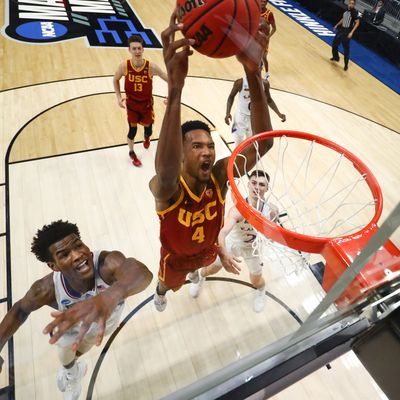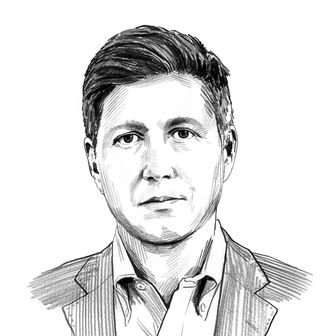
College sports in their current form must exist, the NCAA and basically anyone who defends the system will tell you, because they have always existed. Sure, you wouldn’t come up with the NCAA if you were starting from scratch: It’s impossible to imagine anyone putting “not paying athletes a salary even though their work results in billions of dollars of revenue” in their start-up’s business plan. But in context, the tradition has value. Schools expand their profiles and enrollees; alumni feel pride in their universities; athletes get a free education and the ability to showcase their work for potential future employers. Mostly: It has always been like this. This is a part of who we are. The Galloping Ghost. March Madness. The Heisman. Win one for the Gipper. College sports don’t just represent tradition; they are tradition.
How surprising it was, then, to see Brett Kavanaugh, of all people, tear the whole thing apart while appealing to that very tradition. On Monday morning, the U.S. Supreme Court unanimously nixed an NCAA argument that it can limit “education-related payments to student-athletes,” saying it violated antitrust law. But it was a concurrence by Kavanaugh that struck the NCAA at its core. Kavanaugh argued that simply limiting the organization in this particular case did not go far enough. He made the case that the NCAA’s whole business model was fundamentally flawed.
Putting aside for a moment the very Kavanaugh-specific hilariousness of the justice’s insistence that “lacrosse championships on Memorial Day weekend” are highly popular events — yes, Brett, who among us did not gather with our loved ones in May to cheer on the brave laxmen — the key phrase is the most devastating one: “The NCAA is not above the law.” And there was more.
Kavanaugh makes it clear that no one should expect the Court to have the NCAA’s back in any future lawsuits against its business model, lawsuits that are surely coming. But he goes even farther by labeling the business model, which has been around for 150 years, absurd and exploitative. These sentiments would have been considered revolutionary had I professed them in this column space a decade ago. To hear them coming from a face of modern conservatism is flabbergasting and speaks to just how quickly the public sentiment on paying athletes — something not disconnected from how many billions television contracts suddenly poured into the sport over the last decade — has changed.
This isn’t a death knell for college athletics, but it invites one to begin listening for some bell-ringing. And it sure looks like the NCAA is a dead organization walking, since its central stated reason for being — keeping college athletes amateurs — just blew up in its face in the most dramatic way imaginable.
Whenever one has argued for college athletes to be paid, those who defend the current system have responded with some variation of, “Okay, how would you fix it?” This was a reasonable question. Do you pay some athletes but not all of them? Do colleges have to dig into their non-athletic funds? Do players get traded from one school to another in the middle of the school year? Do they even bother going to school at all? I always struggled to come up with answers to these questions, about how to reconcile the college sports I love with the financial and logistical realities of the situation. It used to frustrate me. But then I realized that throwing the question back at anyone who asked it was simply a way to deflect from complicity with an unjust system. What do you have that’s better? is not a defense of a corrupt model; it is a way to maintain your place in it. Whether you were a coach making millions off unpaid labor, a university or conference (or an organization like the NCAA) cashing billions in television checks, or just a fan who loved watching college sports so much that you never wanted it to change, defending the current way of doing things required rhetorical jujitsu. And that was a sure sign that it wasn’t really worth defending.
What the Supreme Court and Kavanaugh did on Monday was flip the focus: Now it’s up to the NCAA and administrators and university presidents to come up with a plan to save their sports — or else. The NCAA not only has to justify its own existence; it has to justify the entire notion of college athletics.
This will not happen immediately. As Kavanaugh noted, the overall ruling was limited to education-related payments. But cases that go farther in scope are coming, and the Court has given a green light for them to proceed and to thrive. This is just getting started.
Look, I have season tickets for both my local college basketball team and my college football team. I’ve watched every basketball game my alma mater has played for nearly a decade. I love college sports, and I do not want them to go away. With this much money on the line, it’s tough to see how they could go away. But it’s also tough to see the people currently in charge of college athletics, along with all the different constituencies they must represent, ever figuring out a plan to make a new system work. The NCAA has been arguing for decades that amateurism is absolutely critical for college athletics to survive. In order to survive, it will have to prove that everything it’s been saying for decades was wrong all along. Maybe it can be done, but it might require burning down the village to save it. Maybe smaller schools drop sports entirely; maybe larger schools become affiliates of professional teams; maybe everybody just switches jerseys pregame. Who knows? If college sports are as important to all the fans and alumni as we’ve all been claiming it is, we’ll let it burn through what’s about to be a wildly transformative period and still be waiting on the other side. But we’re about to witness quite the bonfire.






























